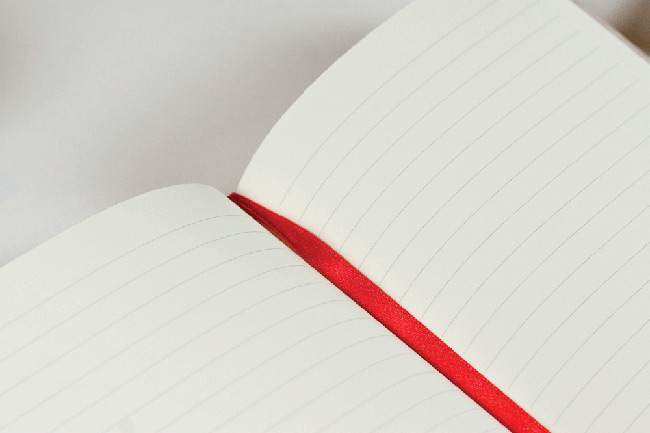
As we discussed in a previous article on Factors to Consider When Buying a Writing Journal, the quality of a notebook’s paper can be fairly important. The nicer the paper the more pleasant your writing experience will be. Anyone whose written in both a generic drug-store brand notebook and something with a higher-grade paper will be able to tell you the same – the quality of the paper makes a difference!
So we’ve decided to compile a list to help you spot the good stuff from the bad. See below for four signs your writing journal or notebook has high-quality paper.
1. Smooth Finish
This one’s easy: if the paper has a smooth finish not only will it look nicer but it will be pleasant to touch. What you might want to avoid is paper with too much pulp. Too much pulp will lead to short fibers that can get picked up by your pen’s point. This is especially annoying if you’re using a fountain pen. (All of those little fibers will accumulate into annoying fuzzballs that will have to be removed from the pen.)
However, you also might not want the paper to be too slick. Overly slick or coated paper – like the paper found in a magazine – will be too difficult to write on. You won’t be able to make the friction necessary for ballpoint pens and the ink from a fountain pen won’t be able to absorb into the paper easily. So to sum up: you want the paper to be smooth but not too smooth.
2. Minimal Feathering
Feathering is when ink smears on the page, especially at the edges of your writing. (See the image on the right for an example.) This usually results from low grade or thin paper that absorbs too much of the ink. Higher grade paper, however, will usually prevent too much absorption and ensure ink stays on the surface.
3. High Opacity
Also related to a paper’s thinness is the degree to which ink bleeds through to the other side of the page (or “Show-Through”). This has to do with a papers’ “opacity” (which is “the property of paper which obstructs the passage of light and show-through of printing.“) Generally, the lower a papers’ opacity is the more the ink will bleed through the other side of the page. In extreme cases the ink could soak into the next few sheets underneath. Anyone who’s experienced this first-hand knows – it doesn’t make for a very pleasant writing experience! Nice quality paper will always have high opacity and little to no show-through.
4. Ink Drys Fast
Finally, there’s the speed to which pen ink will dry on the page. This can sometimes be related to the choice in ink, but generally paper can affect the drying time. If ink drys too slow: your writing could be easily rubbed off or smeared before it sets into the page. (This is especially problematic for lefties, whose hands tend to immediately rub up against their fresh writing!) Generally, you want the ink to dry fairly fast!
Have We Missed Anything?
If we’ve missed anything important feel free to tell us in the comments section below!
To learn more about the paper quality of a Paperblanks notebook, watch this video on the subject.
About Paperblanks: We have been producing superb writing journals for nearly twenty years. We are book people, and we believe that the written word matters and that our blank books have a critical role to play in the art and continued practice of writing itself. For more about Paperblanks, go to our website at paperblanks.com.





I always thought feathering was the ink being absorbed into coarse paper fibers via a capillary effect, rather than surface smearing, and that coated paper or paper with a finer “grain” avoided this.
You are correct, Bret. 🙂 Feathering does occur because of course fibers and as a result of a capillary effect. The effect spreads the ink away from where its supposed to go. I suppose what we meant to communicate was that feathering has the *appearance* of smearing. Good catch! 🙂
You have great comments about picking the right journal to write in. Thanks for sharing it. 🙂
The quality of Paperblanks pages is not to be denied. Everything stated above holds absolutely true, and I was very much impressed. I found very few things on the “par” level – EVERYTHING else (and there are a awful lot of things in the category of “other stuff”) was beyond exceptional.
The covers are undeniably attractive. While the images are beautiful, nothing compares to holding it in your hands. At first I was a little uncertain of them as the “leather” books aren’t real leather (this seemed odd to me, and I was worried that the mix-up of looks versus reality would put me off), but once I was able to handle them in person, I immediately found that I prefer them even to genuine leather (as those can be ruined easily, and that doesn’t seem to be the case with these!) The covers also act as a shield for the edges of the papers.
The paper holds up very well under an eraser, and I was pleased to discover that the lines of the paper can disappear after a bit of rubbing — very handy if one writes in ink and wants to write in straight lines where the guides can later be erased. The paper also takes exceptionally well to any sort of writing utensil, and I don’t say that lightly. It feels smooth to the touch, but has a nice grip – maybe even the “perfect” grip, which delighted me to no end. It’s really not every day you see any sort of paper available to write on with such astounding quality.
The watermarked lines (both for sizing columns and for regulating the height of letters) were a delightful surprise that I love to take full advantage of. They aren’t very noticeable except at an angle in bright lighting, so they never detract from the reading experience later on.
The little extra tidbits – the ribbon marker and the compartment in the back – are both useful and appealing in appearance. It makes a nice touch that seems to round out the whole journaling experience.
I could fill an entire Paperblanks journal with how much I love these books and why – but that doesn’t mean there isn’t at all anything on the “par” level, as mentioned before. There only seem to be three, and they’re minor ones at that:
1. I tend to write firmly no matter what, which creates an indent to show up on the other side of the page and sometimes on the next page as well. If you’re writing on the opposite side, these impressions can transfer pencil lead and ink to the page under it. Upon erasing, the impressions are visible even under the new writing, which makes for a slightly messy look (as does the ink/lead transfer). This sort of thing happens with lesser-quality journals as well, so I shan’t grumble too much. I’ve taken to fitting an ultra-thin, flat, and unyielding journal-sized plate (similar to a clipboard, sans clip) under the page I’m using, which eliminates both problems entirely. I may be the only one to notice or care about such things, but in case I’m not, I do think the idea of Paperblanks possibly offering an optional, appropriately sized writing board even for an added cost for people like me would be absolutely grand.
2. When turning pages, some inner corners where it connects to the binding fold upwards and out. This isn’t really a huge problem, as the page corner is easy tucked back in again, but I wonder about the strength of binding and fear the possibility of accidental crimping.
3. The very first lined page is connected near the binding to the colorful flyleaf (which I love for both the aesthetics and the privacy it lends to the journal) and won’t lie flat until you turn the page. The journal tends to open to the second and third pages on its own, even, which almost negates the idea of using the first page at all. I’m tempted to try to pry the flyleaf and the first lined sheet apart, but I worry about damaging the journal in the attempt.
On a scale of 1-10, I would still give Paperblanks journals a 9.99 repeating and they deserve every recommendation and bit of praise. The journals are of the most astounding quality, and three minor annoyances in a sea of merits are certainly not enough to turn me off. Hands down, these are still the best journals I’ve ever laid my mitts on… I’m simply very particular and admittedly snooty about the three things mentioned above.
Those were very helpful tips. You covered the topic comprehensively.
Kudos.
Keep penning!
Biao